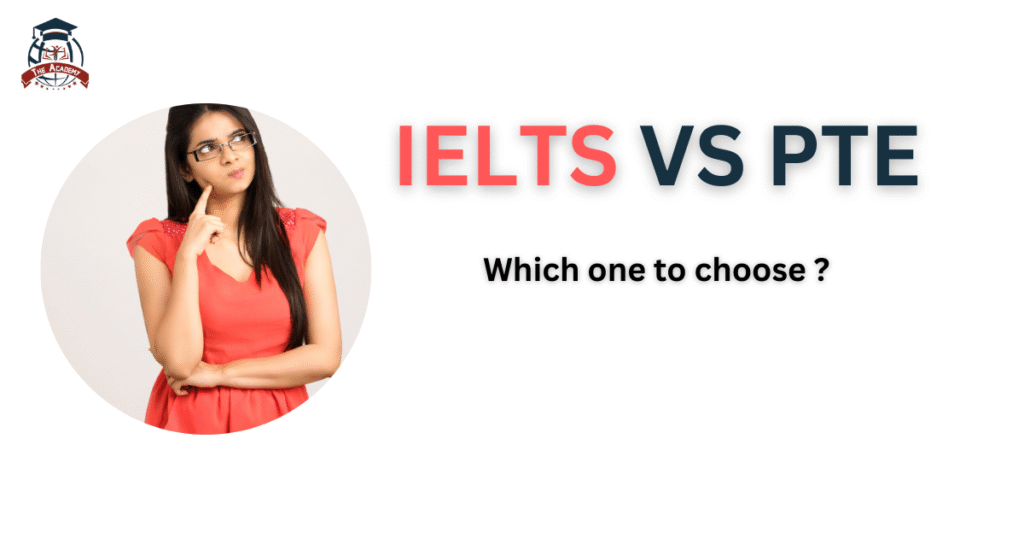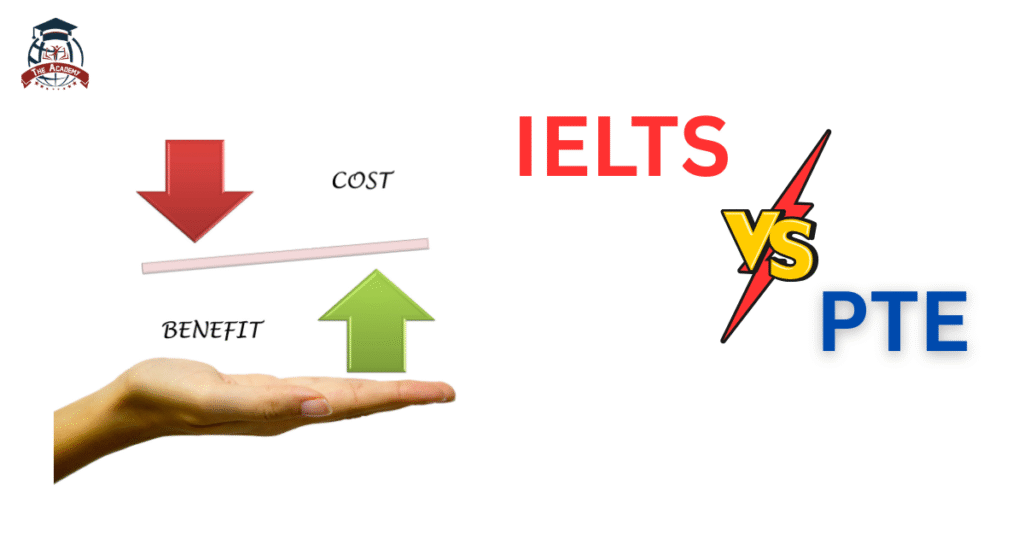IELTS vs PTE 2025: Everything You Need to Know Before Booking Your Test
IELTS vs PTE, this is very confusing for many test-takers when deciding for the English proficiency test, for example, Which English proficiency test is easier? which English test can give high scores, which is easy to handle. With these basic questions both the exams are accepted in most of the World for study, work, and migration. Both differ in structure, scoring, and test day experience. There are five key points, test format, scoring system, difficulty level, AI based evaluation with computer , and global acceptance to help you deciding between IELTS vs PTE.

Table of Contents
IELTS vs PTE: Decoding the Dilemma of Choosing the Right Test
Choosing the right English test is a key step toward your dream of studying or settling in an English-speaking country. Whether your goal is a university degree in Australia, Canada, or the UK or starting a new life abroad proving your English skills is essential. Among the most popular options between IELTS vs PTE many test takers wonder which one suits them best.
In this guide, we’ll break down everything you need to know about IELTS vs PTE. You’ll learn how the tests work, their key similarities and differences, how each is scored, and practical preparation tips to help you perform your best. By the end, you’ll have a clear understanding of which exam fits your plans—whether for migration, study, or simply choosing the easier path for your goals.
IELTS vs PTE: Similarities and Differences
Both IELTS and PTE are globally recognized English proficiency tests, accepted by universities, immigration authorities, and professional organizations worldwide. Their shared goal is to assess your Listening, Reading, Writing, and Speaking skills, but they differ in format, scoring, and overall test experience.
IELTS (International English Language Testing System) remains one of the most trusted exams, offering two main versions: IELTS Academic for higher education and professional registration, and IELTS General Training for migration or work purposes. Today, IELTS is primarily delivered on computer, and a key feature is the One Skill Retake, which allows candidates to retake just one section—Listening, Reading, Writing, or Speaking—without repeating the entire test.
PTE (Pearson Test of English Academic), on the other hand, is fully computer-based and uses automated AI scoring for all sections. Its integrated format combines some tasks, such as speaking and writing, which can make the test feel faster and more streamlined.
In terms of timing and delivery, IELTS computer-based sessions take about 2 hours 45 minutes, with the Speaking test sometimes scheduled separately, while PTE is typically completed in around 2 hours, with all sections taken in a single sitting. IELTS uses a 0–9 band scale with human examiners for Writing and Speaking, whereas PTE scores on a 10–90 scale using AI for quick, consistent results.
Your choice between IELTS and PTE depends on your preparation style, comfort with computer-based tasks, preferred test-day experience, and the specific requirements of the universities or immigration authorities you’re applying to.

.
Quick snapshot: what changed in 2025
- IELTS: Widely available as a computer-delivered test (Reading/Writing/Listening on computer; speaking still may be in-person or via approved online formats per provider). Computer-delivered IELTS gives faster results and much wider test availability in many regions.
- PTE Academic: From 7 August 2025 Pearson introduced two new speaking tasks (Respond to a Situation; Summarize Group Discussion), modestly extended total time, and moved to a hybrid AI + human-review scoring model for several tasks.
1 Test Format Comparison: IELTS vs PTE
Both tests evaluate Listening, Reading, Writing and Speaking but format, timing, and the way responses are captured differ.
Listening Comparison
- IELTS (computer-delivered): Listening recordings are played once; answers entered on-screen. Types include multiple-choice, matching, map/diagram labeling, and completion tasks. Results for computer-delivered tests are returned faster than paper.
- PTE: Integrated computer-based listening tasks (summarize spoken text, select missing word, highlight incorrect words, etc.). Clips may be multi speaker or lecture-style; many tasks require quick note-taking and typed responses.
Example Practice (IELTS Listening sample MCQ)
A short lecture explains three study methods: spaced repetition, active recall, and group discussion.
Question: Which method was NOT mentioned?
a) Group discussion
b) Spaced repetition
c) Flashcards
d) Active recall
Answer: c) Flashcards (unless explicitly stated, flashcards are a tool, not listed in the lecture).
Example Practice (PTE Listening Summarize spoken text)
Audio excerpt (40 sec) explains benefits of urban green spaces.
Model summary (20–30 words): “Urban green spaces improve air quality, reduce heat, and boost mental health by providing recreational areas and habitats for wildlife.”
Reading
- IELTS (computer-delivered): 3 long passages, 40 questions, 60 minutes. Question types include True/False/Not Given, Matching Headings, sentence completion. Computer delivery allows easier navigation and faster results.
- PTE: Shorter timed reading tasks (reorder paragraphs, fill in the blanks, multiple choice). Emphasis on speed, collocation awareness, and grammar.
Practice (IELTS Reading True/False/Not Given)
Passage: The company launched its new carbon-neutral factory in 2019 and reported reduced emissions the following year.”
Statement: The company reported reduced emissions in 2020. True
Practice (PTE Reading Reorder paragraphs)
Given 4 sentences, arrange into coherent paragraph.
Strategy: identify opening sentence (topic sentence), sequence events or cause effect, match pronouns.
Writing
- IELTS (computer-delivered): 2 tasks (report/letter for General or graph-report for Academic; plus 250-word essay). Computer-based writing uses keyboard; candidates still plan and compose essays as before.
- PTE: Summarize Written Text (single-sentence summary) + Essay (200–300 words). Recent PTE updates keep essay task but add more speaking-writing integration. Hybrid scoring now includes human review for select written tasks.
Practice (IELTS Writing Task 2 250 words essay)
Prompt: “Government should fund public transport rather than roads. To what extent do you agree?”
Model approach: 4-paragraph essay: introduction (position), two body paragraphs (reasons/examples), conclusion (restated position and recommendation).
Practice (PTE Writing — Summarize Written Text)
Text: “Remote working increases productivity for many, but can hurt collaboration.”
One-sentence summary: “Remote work boosts productivity for some employees but may reduce team collaboration and innovation.”
Speaking
- IELTS: On the computer-delivered test, speaking is still conducted by an examiner (face-to-face) in most test-center formats, though some online variants or local policies may allow remote/online speaking; check local provider. Computer delivery does not mean AI-scored speaking for IELTS.
- PTE (Aug 2025 updates): Speaking tasks are computer-recorded and scored by AI with human review on several tasks (including the new tasks), making evaluation faster but with additional human checks for authenticity.
Example: Practice (IELTS Speaking, Cue Card)
Topic: Describe a memorable holiday. (1–2 min).
Tip: Use a quick 1-sentence introduction, 3 detail points (where, what, who), and one concluding sentence about why it mattered.
Example: Practice (PTE Speaking Respond to a Situation NEW)
Prompt: “A team member missed an assignment deadline; respond to your manager via a brief message.”
Model (40 sec): “I’m sorry for the delay. I had a technical issue but the work is now complete and attached. I’ll implement a backup plan to avoid recurrence.”
2 Scoring:
- IELTS bands vs PTE scale: Human vs AI
Band vs scale
- IELTS: 0–9 band scores, reported to nearest 0.5.
- PTE: 10–90 scale (more granular), mapping tables exist to convert between PTE scores and IELTS equivalents.
Human vs AI
- IELTS: trained human examiners grade writing and speaking (consistency via training & moderation).
- PTE: historically AI-scored; Aug 2025 changes introduce hybrid scoring, AI plus human review for several speaking/writing tasks to improve fairness. This reduces purely automated mis-scorings and brings PTE closer to human moderation while retaining fast turnaround.
3 Difficulty: Which test feels easier? It depends.
- If you are fast at typing, comfortable talking to a computer, and like structured responses, PTE tends to feel easier.
- If you prefer face-to-face interaction, handwritten planning (if paper), and open essay expression, IELTS may suit you better — though now that IELTS is largely computer-delivered, that advantage shifts mostly to speaking comfort.
Factors to consider: grammar/vocab demands, accent tolerance (PTE AI may be sensitive to pronunciation cues; IELTS examiners accommodate accent variety more flexibly), and test pace.
4 Global acceptance: study, work & migration
- IELTS remains widely accepted worldwide (11,000+ institutions) and is commonly required for many immigration routes. Computer-delivery has increased availability and faster reporting.
- PTE continues to expand acceptance and is accepted by many universities and immigration authorities (Australia, New Zealand, Canada, UK) and its 2025 changes aim to keep pace with academic and workplace English needs.
Action: Always check official university/immigration websites for the specific test (IELTS vs PTE) and required score level before booking.
5 Test day experience & practical considerations
Computer skills & keyboard tips (essential for both tests if computer-delivered)
- Typing: Aim for 30–40 WPM for comfortable essay completion.
- Shortcuts (for practice): Use
Tabto move fields,Shift+Tabto go back,Ctrl+Fwhen practicing on PDF passages, and learn the test interface in mock software. - Microphone checks: Do mic checks pre test; speak clearly into the center of the mic for PTE; in IELTS speaking, speak naturally to the examiner.
Time management
- IELTS Reading: 60 minutes / 40 Questions , 1.5 minutes per question; skim first.
- PTE Reading: shorter sections, focus on speed and grammar accuracy.
Practice set Combined (IELTS & PTE) with model answers
IELTS practice (Reading True/False/Not Given)
Passage excerpt: “The 2019 study showed a 20% increase in city bicycle use after new cycle lanes were installed.”
Statement: The installation of cycle lanes led to a 20% increase in bicycle use in 2019. → True
PTE practice (Summarize Group Discussion NEW)
Audio gist: Three students discuss campus recycling: one suggests deposit-return bins, one proposes education campaigns, one suggests partnerships with recycling companies.
Model summary (40–60 words): “The group explored improving campus recycling through deposit-return bins to encourage returns, education campaigns to change behaviour, and partnerships with local recyclers to handle waste effectively. They agreed a combined approach would increase participation and reduce operational costs.”
IELTS practice (Writing Task 2 sample outline)
Prompt: “Governments should spend more on public transport than on roads. Discuss.”
Outline: Intro (thesis), Para 1 (benefits of public transport: less pollution, equity), Para 2 (cost, long-term benefits), Para 3 (counterargument: roads important), Conclusion (recommend balanced investment with priority to PT).
PTE practice (Respond to a Situation NEW)
Prompt: “A customer complains the product arrived damaged. Respond.”
Model (30–40 sec): “I’m very sorry your order arrived damaged. Please send a photo of the packaging and the product; we’ll arrange an immediate replacement or refund and cover return postage. Thank you for your patience.”
IELTS practice (Speaking cue card)
Topic: Describe a goal you achieved.
Model: 1 sentence intro, 3 supporting details (goal, steps, outcome), 1 sentence conclusion reflecting learning.

IELTS vs PTE: Scoring and Evaluation Results Comparison and How it Works?
There are also significant differences between IELTS and PTE in terms of scoring.
IELTS scores range from 0 to 9 Bands for each skill, with an average score making up the final band. Qualified examiners mark each section manually, especially in the Speaking and Writing sections. As a result of this human element, feedback can be nuanced, but may also lead to variations.
PTE assigns a score from 10 to 90 across listening, reading, speaking, and writing. While its AI driven scoring ensures speed and consistency, Pearson has recently introduced human review for selected Speaking and Writing tasks including the Describe Image, Retell Lecture, and Essay responses to enhance fairness and accuracy. This hybrid system helps catch issues such as mispronunciations, awkward pauses, or technical glitches that AI alone might misinterpret, giving test-takers greater confidence that their final results reflect true language ability.
Candidates who prefer a more objective and instant scoring system might prefer PTE, while those seeking a more balanced evaluation may find IELTS more appealing.

IELTS vs PTE: Exam Preparation: Which is Easier to Prepare
Preparation for each test depends on personal strengths, resources available, and comfort with different test formats.
Its longstanding presence means it has a larger support community, including forums, videos, and tutoring resources, which can ease preparation.
On the other hand, computer-based structure of PTE makes it easier for tech savvy candidates to prepare online. IELTS provides a widely supported preparation community and a wide range of resources.
A lot depends on your personal preferences and objectives when choosing between IELTS and PTE.
Its face-to-face speaking format may also benefit candidates who are comfortable interacting with people directly. Many immigration authorities accept IELTS General Training for immigration to the UK, Canada, Australia, and New Zealand.
Due to its objective, AI-driven scoring, PTE Academic is also widely accepted as a test for study and migration in Australia and New Zealand.
In terms of language strengths, candidates comfortable with speaking on a microphone and performing well in timed, computer-based tasks may find PTE easier. IELTS may be a better fit for those who enjoy conversational settings or have experience with traditional exam formats.
For an easier option, choose the test that aligns with your comfort level – IELTS for a human touch and PTE for a tech-based approach.
IELTS vs PTE: Which Test Should You Take?
The decision between IELTS vs PTE depends on your migration or study abroad goals, comfort with technology, and personal test-taking style. Both exams offer global recognition but differ in format and experience.
PTE is fully computer-based with automated scoring, ideal for fast typists and those who prefer consistency and quick results. IELTS, while also now delivered on computer in most locations, provides a broader preparation base and includes live interaction with examiners, which some candidates find more natural.
The “easier” test will vary from person to person — consider your strengths, preferences, and end goals when choosing.
Final Recommendations:
- Check requirements first: Confirm which test your university or immigration authority accepts.
- Match the test to your strengths: Fast typists can consider PTE; comfortable with live speaking is IELTS.
- Practice on a computer: Since both IELTS and PTE are fully digital in 2025.
- Simulate test conditions: Time yourself, type essays, record speaking tasks, and self evaluate.
- Use updated materials: PTE (post-Aug 7, 2025) includes new speaking tasks practice with the latest versions.
FAQs About Choosing between IELTS vs PTE
Q1. Which is easier, IELTS vs PTE?
Both IELTS and PTE have unique challenges. PTE is fully computer-based with AI scoring, which some students find easier, while IELTS includes human examiners, especially in the Speaking test, which can feel more natural for others.
Q2. Is PTE accepted more widely than IELTS?
No. IELTS is accepted by over 11,000 institutions worldwide, making it slightly more recognized than PTE. However, PTE is rapidly gaining global acceptance, especially for Australia, New Zealand, and Canadian immigration.
Q3. Which test is better for migration: IELTS or PTE?
For Australia and New Zealand, both IELTS and PTE are equally accepted. In Canada and the UK, IELTS is still more commonly required, but PTE is now accepted in many visa categories.
Q4. Is PTE scoring more accurate than IELTS?
PTE uses AI-based scoring, which is consistent and quick. IELTS relies on human examiners, offering more flexibility in assessment. Some students prefer PTE for its speed, while others trust IELTS for its human evaluation.
Q5. Which test is cheaper, IELTS or PTE?
The test fees are almost similar, but it varies by country. On average, IELTS costs between $245–$255, while PTE costs around $220–$235. Always check the latest fee in your region before booking.
Q6. How fast do I get results in IELTS vs PTE?
PTE results are usually available within 48 hours to 5 days, while IELTS results take 3–5 days (computer-based) and up to 13 days (paper-based).
Q7. Should I take IELTS or PTE if my typing speed is slow?
If you struggle with typing, IELTS may be a better choice since it allows handwritten responses (paper-based) or typing (computer-based). PTE requires strong typing speed as the entire test is computer-based.
